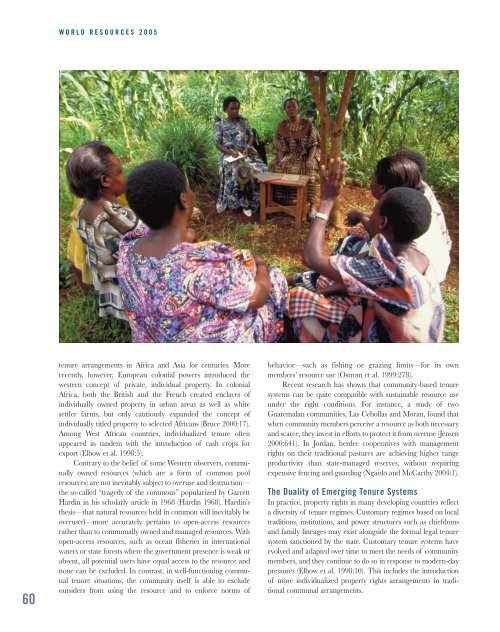jp8589 WRI.qxd - World Resources Institute
jp8589 WRI.qxd - World Resources Institute
jp8589 WRI.qxd - World Resources Institute
You also want an ePaper? Increase the reach of your titles
YUMPU automatically turns print PDFs into web optimized ePapers that Google loves.
WORLD RESOURCES 2005<br />
60<br />
tenure arrangements in Africa and Asia for centuries. More<br />
recently, however, European colonial powers introduced the<br />
western concept of private, individual property. In colonial<br />
Africa, both the British and the French created enclaves of<br />
individually owned property in urban areas as well as white<br />
settler farms, but only cautiously expanded the concept of<br />
individually titled property to selected Africans (Bruce 2000:17).<br />
Among West African countries, individualized tenure often<br />
appeared in tandem with the introduction of cash crops for<br />
export (Elbow et al. 1998:5).<br />
Contrary to the belief of some Western observers, communally<br />
owned resources (which are a form of common pool<br />
resources) are not inevitably subject to overuse and destruction—<br />
the so-called “tragedy of the commons” popularized by Garrett<br />
Hardin in his scholarly article in 1968 (Hardin 1968). Hardin’s<br />
thesis—that natural resources held in common will inevitably be<br />
overused—more accurately pertains to open-access resources<br />
rather than to communally owned and managed resources. With<br />
open-access resources, such as ocean fisheries in international<br />
waters or state forests where the government presence is weak or<br />
absent, all potential users have equal access to the resource and<br />
none can be excluded. In contrast, in well-functioning communal<br />
tenure situations, the community itself is able to exclude<br />
outsiders from using the resource and to enforce norms of<br />
behavior—such as fishing or grazing limits—for its own<br />
members’ resource use (Ostrom et al. 1999:278).<br />
Recent research has shown that community-based tenure<br />
systems can be quite compatible with sustainable resource use<br />
under the right conditions. For instance, a study of two<br />
Guatemalan communities, Las Cebollas and Moran, found that<br />
when community members perceive a resource as both necessary<br />
and scarce, they invest in efforts to protect it from overuse (Jensen<br />
2000:641). In Jordan, herder cooperatives with management<br />
rights on their traditional pastures are achieving higher range<br />
productivity than state-managed reserves, without requiring<br />
expensive fencing and guarding (Ngaido and McCarthy 2004:1).<br />
The Duality of Emerging Tenure Systems<br />
In practice, property rights in many developing countries reflect<br />
a diversity of tenure regimes. Customary regimes based on local<br />
traditions, institutions, and power structures such as chiefdoms<br />
and family lineages may exist alongside the formal legal tenure<br />
system sanctioned by the state. Customary tenure systems have<br />
evolved and adapted over time to meet the needs of community<br />
members, and they continue to do so in response to modern-day<br />
pressures (Elbow et al. 1998:10). This includes the introduction<br />
of more individualized property rights arrangements in traditional<br />
communal arrangements.

















